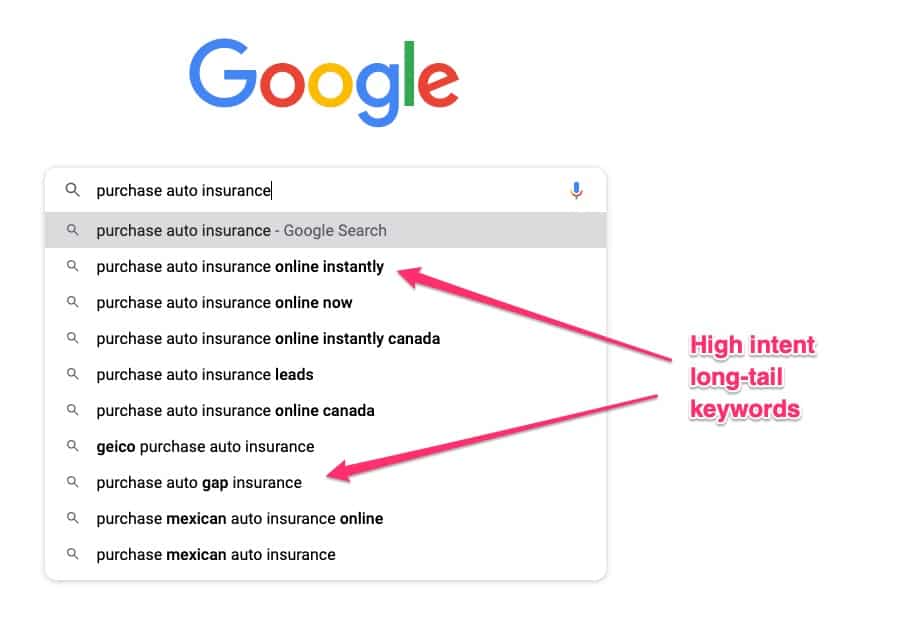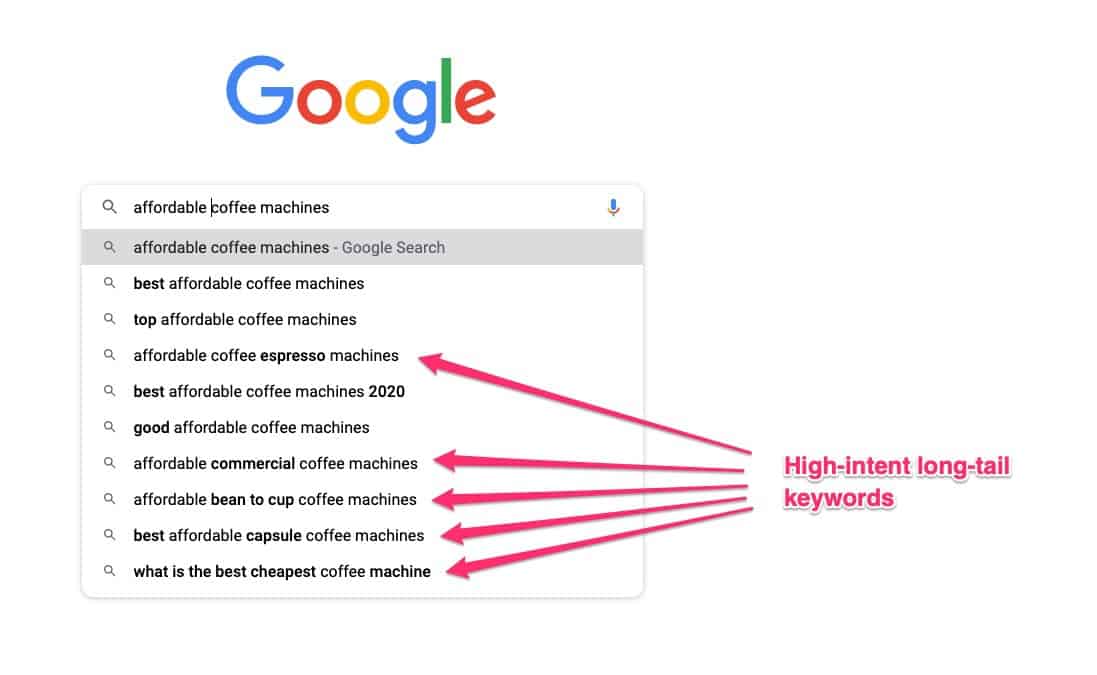High-intent keywords are keywords where there is a strong likelihood that the searcher will take a particular action.
They are different from ‘awareness’ and ‘consideration’ keywords, where the intent is simply to gather information.
What is Keyword Intent?
Keyword intent is the purpose the searcher had when they typed their search query into Google. It’s also known as search intent, searcher intent, and query intent.
The intent behind a keyword is a vital part of search engine optimization. In fact, it’s the key to getting your pages ranked on Google.
Let’s say you manage to get your article on Page #1 of Google for a certain keyword. If your blog post or web page does not address the intent behind that keyword, searchers who click on your article will quickly return to the search results when they realize that your page doesn’t answer their question.
The Google algorithm will notice this and it will start to push your page down the search results.
On the other hand, if your page addresses the intent behind the keyword better than any other page in the search results, Google will push your page higher up the search results.
Three Kinds of Keyword Intent
Broadly speaking, when people go to a search engine, they type in one of three different kinds of search queries:
- Navigational
- Informational
- Transactional
Navigational searches are when a searcher types in the name of a website, such as CNN or Amazon, or YouTube.
You don’t have to have a brand name to do a navigational search. A person might have forgotten the name of the website so they type in a description of what it does. For example, someone looking for Etsy might type in “platform that sells handmade products”.
But what makes a navigational search different from any other kind of search is that the searcher wants to go to a specific website that they already know about.
An informational search is a search for information (no surprises here). An example would be “distance from New York to Los Angeles”, or “smallest country in Africa”, or “convert ounces to grams”.
A transactional search is a search by someone who wants to buy something. An example would be “running shoes for men”, or “wall mounting for TV”.
High Intent Keywords
High intent keywords, also known as ‘buyer keywords’, are usually transactional keywords. They are keywords that indicate that the searcher wants to purchase something
Of course, some transactional keywords have higher intent than others.
For example, “buy dslr camera under $1000” is a transactional keyword but it doesn’t have as much intent behind it as “buy Nikon D7100”. With the first keyword, the searcher wants to buy a camera but they haven’t decided which one. With the second keyword, the searcher knows exactly which camera they want to buy: the intent is much higher.
35 Formulas For Finding High Intent Keywords
The best way to find high intent keywords related to your product or service is to use Google Search.
Go to Google and type in your product or service together with a keyword modifier.
Here are the three main types of keyword modifiers that signal commercial intent:
Comparison modifiers
Use the combinations below to find intent long-tail keywords in Google Auto Suggest:

#01 – [keyword] + alternatives
#02 – [keyword] + review
#03 – compare + [keyword]
#04 – [keyword] + comparison
#05 – top + [keyword]
#06 – best + [keyword]
#07 – [keyword] + vs
#08 – [keyword] + versus
#09 – [keyword] + pros and cons
#10 – [keyword] + ratings
Buying modifiers
Use the combinations below to look for high-intent long-tail keywords in Google Auto Suggest:

#11 – buy + [keyword]
#12 – purchase + [keyword]
#13 – buy online + [keyword]
#14 – order + [keyword]
#15 – best range + [keyword]
#16 – find + [keyword]
#17 – get + [keyword]
#18 – locate + [keyword]
#19 – where to buy + [keyword]
#20 – popular + [keyword]
Price modifiers
Use these price modifier combinations to look for high intent long-tail keywords in Google Auto Suggest:

#21 – [keyword] + prices
#22 – [keyword] + pricing
#23 – [keyword] + best price
#24 – discount + [keyword]
#25 – [keyword] + deals
#26 – [keyword] + best deals
#27 – [keyword] + coupon
#28 – [keyword] + free shipping
#29 – affordable + [keyword]
#30 – cheapest + [keyword]
#31 – cheap + [keyword]
#32 – [keyword] + offers
#33 – [keyword] + sale
#34 – [keyword] + low price
#35 – [keyword] + promo code
FURTHER READING
- Yext: What Are High-Intent Keywords?
- Convince & Convert: How Keyword Intent Can Boost Your Conversion Rate
Conclusion
With the right modifiers, high intent keywords are easy to find.
Use these 35 keyword modifiers together with Google Auto Suggest, and you’re guaranteed to find long-tail keywords that represent searchers ready to buy your products.
More Articles About Keyword Research
- How To Use Keyword Modifiers To Rank on Google
- How to Find Seed Keywords for Better SEO (2 Simple Methods)
- What Is a Focus Keyword – 7 Tips For Better SEO
- How To Find Long Tail Keywords Using Free & Paid Tools
- How To Rank for Multiple Keywords and Triple Your Traffic
- 21 Types of Keywords in SEO & How To Use Them
- What Are Stop Words In SEO – Everything You Need To Know
- The Keyword Golden Ratio: The Secret To Ranking on Google
- How To Use ‘People Also Ask’ (PAA) For Better SEO
- What Are LSI Keywords & How To Use Them To Rank Higher
- What Is Keyword Research – A Guide For Beginners (2022)
- What Is Keyword Grouping & How Does It Help With SEO?